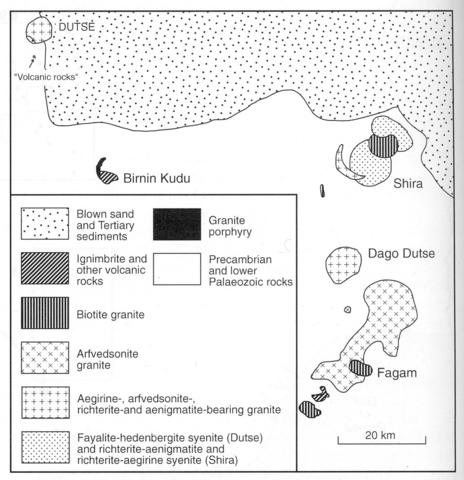stripes
The three centres of the Shira complex, which has an estimated area of 152 km2, are aligned in a north-northeast - south-southeastly direction, but only the southern part of the complex is well exposed. The three centres are of granite and syenite which are generally peralkaline. Probably the most extensive and earliest intrusive phase is a quartz syenite which develops the greatest relief over the complex. There are numerous inclusions of syenite throughout this body and there is a large enclave of peralkaline microgranite. The syenite consists of perthite, 13-15% quartz, amphibole zoned from ferrorichterite to arfvedsonite and sometimes with overgrowths of aegirine, a little aegirine-augite, plentiful aenigmatite and accessory chevkinite, ilmenite, apatite and zircon. An arcuate intrusion of granite cuts the quartz syenite and contains acicular or poikilitic arfvedsonite, which may be concentrated into layers. This rock type also forms dykes and in a boulder, assumed to derive from such a dyke, narsarsukite has been identified. The most northerly intrusion is poorly exposed and is a granite with small aegirine and arfvedsonite crystals enclosed in alkali feldspar, as well as grains up to 5 mm long of ferrorichterite cored arfvedsonites, which are sometimes being replaced by astrophyllite and may have aegirine rims. A small intrusion of syenite within the granite is variably granular, one variety containing sodic amphiboles of varying composition, aegirine and aenigmatite while in another aegirine is the dominant mafic phase. The central area of the complex is occupied by a biotite granite. Six kilometres southwest of the Shira complex occurs a dyke-like intrusion of porphyritic granite containing fayalite and ferrohedenbergite both of which may have narrow rims of ferrorichterite or arfvedsonite. Modal and extensive analytical data for pyroxenes and amphiboles, as well as for fayalite, biotite, plagioclase, alkali feldspar, aenigmatite, narsarsukite, chevkinite and Fe-Ti oxides, are given by Bennett et al. (1984).
BENNETT, J.N., TURNER, D.C., IKE, E.C. and BOWDEN, P. 1984. The geology of some northern Nigerian anorogenic ring complexes. Overseas Geology and Mineral Resources, 61: 1-65.RAHAMAN, M.A., VAN BREEMEN, O., BOWDEN, P. and BENNETT, J.N. 1984. Age migrations of anorogenic ring complexes in northern Nigeria. Journal of Geology, 92: 173-84.

